| |
Malcolm Saville
Page authored by and (c) Jim
Mackenzie
THIS PAGE
CONTAINS SPOILERS!
Page finalised 7th November, 2010.
|
|
The 21st February, 2001 marked the
centenary of the birth of Leonard Malcolm Saville. A full
account of his life and career and other books can be
found on John's
Malcolm Saville site. An excellent companion to the Lone Pine stories
(“The Complete Lone Pine”) was written by
Mark O’Hanlon.
In compiling this Collecting
Books and Magazines tribute to a celebrated writer
for children, the author of this page is aware of the
wealth of knowledge of the members of the Lone Pine Clubs
past and present, and of the depth of the affection in
which Malcolm Saville and his characters are held. A
chance discovery in a second-hand bookshop of “Lone
Pine Five” led to a marvellous journey through the
whole of the series in a few short months. If mistakes
have been made, then this ‘outsider’ is happy
to be corrected. After all, some of you reading these
words grew up with the adventures and have known them a
long time. You were lucky - but then so was I, stumbling
across a treasure like this in the year 2000.
My thanks go to Kim
Miles and Betula
O’Neill who kept me supplied with books until I
ended my quest.
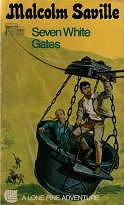
Peter and
Tom above. |

The
Gay Dolphin Adventure |
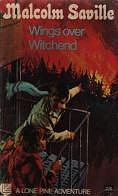
Wings
over Witchend |
Lone Pine Stories
As you can see from the dates below the
stories were written over a period of 36 years. They
started in war-time and ended in the 1970’s. This
inevitably produces inconsistencies but none of them
really matter. When we read “Not Scarlet but
Gold” and hear the Lone Piners asking about war-time
parachutists on the Mynd we do not ask why they
can’t remember their first adventure in 1942. When
Peter (Petronella) wears a mini-skirt in “Rye
Royal” we don’t wonder if she’s in fashion
or hopelessly out-moded, we just wish we were there to
see it !

Not
Scarlet but Gold |
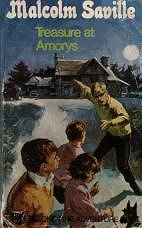
Treasure
at Amorys |
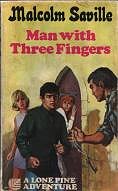
Man
with Three Fingers |
The Lone
Pine Series
Each book is a story in itself and it is not the purpose
of this page to give away so many details of the plots
that they will spoil the enjoyment of anyone meeting
these excellent stories for the first time. Similarly
those meeting or completing the adventures should avoid
reading the detailed article below until the last story
has been read.
Here a mere taste or flavour of the action is given in
each case in the hope that it will jog a few memories and
send you back or for the first time to the best source of
all – Malcolm Saville’s own writing.
1. Mystery at Witchend.
(1943)
Lost in a fog, half way up the hillside, the
resourceful twins hear the hooting of too many owls. The
friendliest of people can turn out to be enemies.
2. Seven White Gates (1944)
Even the Romany caravans keep well clear of
Seven White Gates. Jenny Harman would like to run away
from the village of Barton Beach but one place she
won’t go is up through the “whispering
wood” to the old farmhouse. Peter has to go and stay
there. The Morton twins don’t share Jenny’s
fears but they do share an unusual adventure.
3. The Gay Dolphin Adventure (1945)
Tossing a clod of mud into the face of your
cousin whilst he is sleeping is one way of getting his
attention. Another way is keeping your courage when
confronted by the redoubtable Miss Ballinger.
4. The Secret of Grey Walls (1947)
Girls to the rescue. Vivid dreams come true. A
winter’s night on the hillsides above the sleepy
town of Clun is packed with incident. Read how Penny,
Peter and Jenny deal with things in their own way.
5. Lone Pine Five (1949)
When Tom buys his friend Jenny a present he
little realises the trouble he is getting them into.
Events burst out of the page like water out of the
hillside.
6. The Elusive Grasshopper (1951)
Jon speaks better French than Penny – well,
he would, wouldn’t he ? Deserted schools and
policemen on miniature railways all add to the excitement
as reporter James Wilson enlists the help of the Lone
Piners whilst on a strange assignment.
7. The Neglected Mountain (1953)
Mr. Morton devises an unusual day out for the
Lone Piners. Macbeth, the kidnapped Scottie, leads Peter,
David and Mary into underground trouble.
8. Saucers Over the Moor (1955)
Moonlight on the streets of Rye. Cycle rides on
the roads across Dartmoor. Dan Sturt gets the story of a
life-time. Penny goes out the window and into trouble.
9. Wings Over Witchend (1956)
Through the snow with Peter and the twins.
Through the snow with Peter alone on her pony. High on a
tower with Tom and Jenny. A winter story par excellence.
10. Lone Pine London (1957)
A foggy day in London Town sets Jon on the
trail. Harriet is introduced for the first time and the
Lone Piners become connoisseurs of fine art.
11. The Secret of the Gorge (1958)
Macbeth visits a house full of cats. A mansion
is being demolished and David hurts his knuckles on
somebody’s teeth.
12. Mystery Mine. (1959)
Jon and Penny have a memorable meeting on the
steps up to Whitby Abbey. Harriet proves her courage and
Dickie loses his twin.
13. Sea Witch Comes Home (1960)
And the sea came in. Three Lone Piners are up to
their necks in it – trouble that is ! You almost
feel sorry for the criminal when the twins are on the
trail.
14. Not Scarlet but Gold (1962)
Under the Stiperstones and on the back streets
of Shrewsbury momentous events change the lives of the
older Lone Piners for ever.
15. Treasure at Amorys (1964)
It’s Penny’s turn to dream. Jon again
becomes a man of action. David pines and the twins are
their usual selves.
16. Man with Three Fingers (1966)
Tom is loyal to all his friends even when they
lead him into trouble. Jenny never gives up but it is
David who spots the vital clue.
17. Rye Royal (1969)
Another splendid winter story set in Rye. Peter
discovers new things about the old town and about
herself. Selling books is not always a safe occupation.
Penny spends a lot of time making coffee.
18. Strangers at Witchend (1970)
With the older Lone Piners somehow preoccupied,
Dickie, Mary and Harriet get more than their share of
trouble. None of them, however, gets as much as Macbeth.
19. Where’s My Girl ? (1972)
A really fishy story. Dickie and Mary climb
Mount Morton. Dan Sturt gets on the trail of another
interesting mystery but Jenny is the one who has to start
afresh in her own home.
20. Home to Witchend. (1978)
Peter reaches 18 years of age. Whilst thieves
fall out with each other, the Lone Piners remain true to
the document they signed in the first adventure.
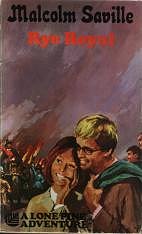
Rye
Royal |
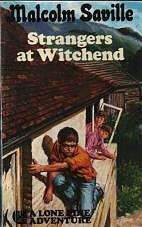
Strangers
at Witchend |
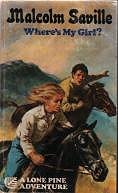
Where's
My Girl? |
Who are the Lone Piners ?
As the books formed themselves into a
series Malcolm Saville would write a foreword to each one
in which he introduced new readers to the characters in
the Lone Pine Club. Later books in the series had subtle
variations in these descriptions as the children grew
older. Sometimes even the relative ages of the characters
changed ! Jenny, who is twelve in the first book where
Peter is fifteen, becomes several months older than Peter
before Peter reaches her eighteenth birthday !
The following descriptions are based on observations
of the whole series of twenty books.
1. David John Morton
David is steady and reliable. The reader comes
to learn that, though he has deep feelings, he tends to
be undemonstrative. This serves him well in most
situations where he can keep his head and ensure that he
plays his role as leader of the Lone Pine Club.
Unfortunately, for a while, his self-restraint and
reserve can lead to misunderstandings with those he cares
for most. He is extremely good-humoured so that the rare
occasions when he loses his temper are made all the more
remarkable. He is clearly of above average intelligence
and, in the sporting field, has a particular love for the
game of cricket. The relationship with his twin brother
and sister is an unusual one. His parents trust him to
take care of them and Dickie and Mary nearly always
eventually obey his orders. He appreciates their courage
and is prepared to tolerate their extraordinary ability
for getting into trouble. Their embarrassing habit of
being cheeky to strangers and standing up for each other
whether they are right or wrong, is a constant trial to
him. As he grows older David gains a new self-confidence
and has made very clear plans about his career in the
law.
2. Petronella (Peter) Sterling
There is nothing about Peter that anyone could
ever dislike and yet this does not make her impossibly
good. She is honest, loyal, remarkably brave, loving,
compassionate, a dutiful daughter and a terrific friend.
And yet she is a very vulnerable person. Her mother died
after her birth and she has lived all her life with her
father in a lonely cottage near the Hatcholt reservoir in
the Shropshire hills. She is intelligent but not an
academic person. She excels at swimming and horse riding.
Though her father sometimes complains about her
untidiness, the two are devoted to each other. Her time
at school in Shrewsbury is not particularly happy and she
has no real long-term school friend. In some ways she is
cut off from the world and her character develops in many
new and interesting ways after she meets the Morton
family. The intensity and strangeness of her dreams adds
tremendous colour to several of the narratives
In the early stories her blonde hair is drawn back
into two old-fashioned plaits. Later she wears it as a
bun and later still it falls attractively to her
shoulders. From the beginning she is always described as
attractive but by the later stories she is stunningly
beautiful. Always in tune with the countryside, Peter has
been taught by her father to love and understand all the
animals and birds, but none means as much to her as her
little Welsh pony, Sally. As Dickie establishes in
“Mystery at Witchend”, Petronella’s
unusual name has been taken from a boat
that her father saw on a beach in Cromer. If her
Christian name is strange, her surname is perfect - for
Sterling means genuine, pure and precious.
3. Tom Ingles
Tom is the oldest of the Lone Piners, and,
throughout the series, is the only one who is in regular
work. His background is filled with tragedy, having lost
both of his parents. He is a city boy, living and
labouring on his uncle’s farm. The world of Tom and
Jenny is narrower than the other four older Lone Pine
characters. Their opportunities to see more than a small
section of Shropshire are restricted. Tom is renowned for
his good humour and his pleasant character. Inevitably
the boundaries of the Ingles farm begins to seem too
small to him and growing to maturity causes him problems
he might not have expected. He even puts at risk those
things that matter the most. Of the three older boys Tom,
used to manual labour evey day of his life, appears to
the strongest and the quickest. Drowned in a regular
deluge of words whenever he meets Jenny, he always
remains instinctively generous and kind to her and his
other friends.
4. Jenny Harman
Unlike Peter Jenny wears her heart upon her
sleeve. The early stories in the series show her coming
to terms with her lack of courage. Later adventures
demonstrate that she has many painful things to learn
before she grows up. Her life at the little
newsagent’s shop in out-of-the-way Barton Beach
seems impossibly dull until she is befriended by Peter
and the Mortons. Jenny’s other escape is into the
world of books and in particular into the world of
romance. With all her emotion ponded up until the
holidays, Jenny becomes very much of a chatterbox when
she is with her friends. Provided with a conventional
stepmother who early on gives every appearance of being
cruel, Jenny’s life seems far more mundane than all
of the others. The Lone Pine Club is her saviour and she
becomes acutely aware of the feelings of all the others
and knows instinctively when Peter is unhappy. Her
particular friend is Tom and she makes no secret of how
much she likes him. It takes a long time for him to
realise that Jenny brings out all the best things in him.
5. Penelope (Penny) Warrender
Penny is another red-head but her character
differs from that of Jenny in several ways. She is quick
and impulsive but also has a deep-down confidence in most
areas of her life. The long years of estrangement from
her parents, who live and work abroad, has had the twin
effect of making her more self-reliant but also briefly
rather awkward when they do return to this country. We
learn that she writes as she speaks and that she is full
of energy and passion. Her cousin, Jon, fills her both
with admiration and with frustration. Much as she would
like to control his behaviour and force him to pay her
more attention, she realises that his independent spirit
is what she admires. Penny appears to be a good mixer and
fits in well in any new situation. David describes Penny
as “very jolly and has red hair and an awful
temper.” One of the best moments in the whole series
is when Peter and Penny meet for the first time and each
realises the other is giving the other appraising
glances. The attraction of opposites applies and even
Peter’s fussy old father can see that the two girls
are good for each other.
6. Jonathan (Jon) Warrender
Jon is both frustratingly intelligent and
reassuringly down-to-earth. He is the most academic of
the Lone Piners with an interest in science and a gift
for languages. At times he appears to treat Penny with
cavalier indifference and at other times it is clear that
he really cares for her. A public school boy like David,
Jon finds the twins rather childish but enjoys planning
expeditions and talking things through with their
brother. Careless of his appearance, bespectacled, and
sometimes seemingly in a world of his own, Jon, always
seems to have his feelings under control. In moments of
crisis it is surprising what resources he finds and the
satisfaction he gets from hitting out at his enemies. He
likes an intellectual challenge but finds also that he
copes quite well when physical action is required.
7. Mary Morton and
8. Richard (Dickie) Morton
At times Mary appears the more dominant of the
twins, especially in the earlier stories. She is singled
out from her brother by her total devotion to Macbeth,
the Scottish terrier, and by the closeness to Peter, who
is like the sister she has never had. Malcolm Saville
makes great play upon the loyalty that the twins have to
each other. He also allows them to behave appallingly
when confronting strangers. The embarrassment factor is
always high when David has to appear in public with them.
Dickie is sometimes portrayed as being unhappy at school
and, in later stories, becomes interested in a career in
journalism, showing, it has to be said, all the worst
aspects of that profession in constantly wanting
attention and a lack of consideration for other
people’s feelings. If the older children are a
little too good to be true, then the twins make up for it
to such an extent that their father sometimes wonders if
they are safe to be allowed out. We are meant to forgive
their behaviour because of their courage but, in fact, it
is their never ending struggle with the English language
which is “acksherley” their biggest redeeming
feature.
8. Harriet (Harry) Sparrow
Harriet is a late-comer on the scene and the
last member of the Lone Pine Club. Life with her parents
is very sketchily drawn in but her grandfather and his
knowledge of antiques plays an important part of several
of the stories. She spends most her time on the periphery
of the adventures until “Strangers at Witchend”
where she has an important role and puts the principles
of the club into action. Although she is closest to the
twins in age and affections, she gives every sign of
growing up to be a kind, sensible and sensitive girl.
9. Macbeth (Mackie)
This poor dog must be one of the most
long-suffering in all children’s literature. His
life is a strange mixture of being incessantly pampered
and of being plunged into fights with unpleasant
criminals. Even in the good times there is little dignity
for a noble-looking dog like a Scottie in being carried
in a basket on Mary’s bike. He has the courage and
ferocity to make life uncomfortable for some of the minor
rogues but he is too small a dog to be a match for
ruthless people who will use their boots or who are not
afraid to hit out with clubs. In other words he is the
ideal companion for the children, being both brave and
vulnerable. In the later stories signs of his age begin
to appear.
BIOGRAPHY
A biography of Malcolm Saville is available.
Entitled "Beyond the Lone Pine",
and written by Mark O'Hanlon with the active co-operation
of Mr Saville's family, it comprises over two hundred
pages of text, photographs and ephemera in a hardback
volume. The price is £17.99 plus postage at cost. CHECK
FIRST AS THIS IS OLD INFORMATION!
Betula topsyturvy@blueyonder.co.uk
Please visit the Topsy-Turvy web-site at; http://www.topsyturvychildrensbooks.co.uk
LETTERS
31.10.2010
I have been a secret member of the Lone Pine Club since David asked me to join in 1967. I can, of course, imitate the sound of the Peewit, ride a bike, stand up for what is good in the world and stay loyal to my friends. Although I may not have had as many adventures as the other, better known, members of the LP Club I have been on the look out for strangers acting suspiciously for the last 43 years ! I know that there are many other secret members of the Lone Pine Club out there and I believe it is time for us to emerge from the shadows and stand firm.
Ben Morris
Back to Collecting
Books & Magazines index page
|








